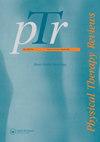Effects of cueing techniques on gait, gait-related mobility, and functional activities in patients with Parkinson’s disease: a systematic review and meta-analysis
IF 0.8
Q4 REHABILITATION
引用次数: 2
Abstract
Abstract Background Parkinson’s disease (PD) is a neurodegeneration of dopaminergic neurotransmitters results in disturbance in gait, balance, and impairs the functional activities. Cueing techniques which are spatial stimuli facilitating repetitive movements are used in combination with other interventions to manage these disturbances. Objectives To determine the effects of cueing techniques for PD patients on the outcomes of gait, balance, functional activity, and freezing of gait. Methods The search was conducted in Medline, CINAHL, Cochrane, OVID and PEDro databases. In addition, a manual search in Google Scholar and reference lists of the included studies was conducted. Randomized Controlled Trials (RCTs) that compare the effects of cueing techniques with other interventions on any of the previously mentioned outcomes for PD patients were included according to the eligibility criteria. Results A total of 8 RCTs were included (n = 239 participants); 5 used auditory cueing, 3 used visual, and 1 used proprioceptive. The results revealed a significant medium effect of non-cueing techniques on gait (MD of 0.41(95% CI, 0.14, 0.68; p = 0.003), a non-significant small effect of cueing on balance (MD of −0.13 (95% CI, −0.52, 0.27; p = 0.54)), and a significant effect of cueing on functional activities (MD of −0.54 (95% CI, −0.86, −0.21; p = 0.001). While no quantitative outcome measures were assessing freezing of gait, a meta-analysis for it was not applicable. Conclusions Cueing techniques are beneficial in improving functional activities and balance. It may not provide a significant change on gait parameters when compared to non-cueing techniques unless combined with other treatment programs.提示技术对帕金森病患者步态、步态相关活动和功能活动的影响:一项系统综述和荟萃分析
摘要背景帕金森病(PD)是一种多巴胺能神经递质的神经退行性变,导致步态、平衡障碍,并损害功能活动。提示技术是促进重复运动的空间刺激,与其他干预措施相结合来管理这些干扰。目的确定帕金森病患者提示技术对步态、平衡、功能活动和步态冻结结果的影响。方法检索Medline、CINAHL、Cochrane、OVID和PEDro数据库。此外,还对谷歌学者和纳入研究的参考文献列表进行了手动搜索。随机对照试验(RCT)根据资格标准将提示技术与其他干预措施对PD患者先前提及的任何结果的影响进行比较。结果共纳入8项随机对照试验(n = 239名参与者);5人使用听觉提示,3人使用视觉提示,1人使用本体感觉提示。结果显示,非提示技术对步态有显著的中等影响(MD为0.41(95%CI,0.14,0.68;p = 0.003),提示对平衡的非显著小影响(MD为−0.13(95%CI,−0.52,0.27;p = 0.54)),提示对功能活动的显著影响(MD为−0.54(95%CI,−0.86,−0.21;p = 0.001)。虽然没有定量的结果测量来评估步态冻结,但对其进行的荟萃分析不适用。结论提示技术有利于改善功能活动和平衡。与非提示技术相比,除非与其他治疗方案相结合,否则它可能不会对步态参数产生显著变化。
本文章由计算机程序翻译,如有差异,请以英文原文为准。
求助全文
约1分钟内获得全文
求助全文
来源期刊

Physical Therapy Reviews
REHABILITATION-
CiteScore
1.30
自引率
0.00%
发文量
26
期刊介绍:
Physical Therapy Reviews is an international journal which aims to publish contemporary reviews, discussion papers and editorials within physical therapy, and in those basic and clinical sciences which are the basis of physical therapy. The journal is aimed at all those involved in research, teaching and practice within the area of physical therapy. Reviews (both descriptive and systematic) are invited in the following areas, which reflect the breadth and diversity of practice within physical therapy: •neurological rehabilitation •movement and exercise •orthopaedics and rheumatology •manual therapy and massage •sports medicine •measurement •chest physiotherapy •electrotherapeutics •obstetrics and gynaecology •complementary therapies •professional issues •musculoskeletal rehabilitation
 求助内容:
求助内容: 应助结果提醒方式:
应助结果提醒方式:


